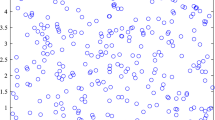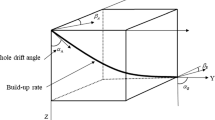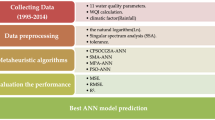Abstract
Numerical oil spill models, which predict the transport and behavior of oil spills, are an essential tool for risk assessment and clean-up during an actual accident. The existing numerical oil spill models are mainly applied to large-scale oil spills, while few models on small-scale oil spills exist. Therefore, this study focuses on the prediction model of small-scale oil spills. Oil diffusion experiments in seawater using different oil types, including heavy oil, light oil, and gasoline, at different addition amounts under various kinds of wind were carried out, and these diffusion processes were recorded by a camera. The experimental images were processed to obtain the spread oil film area. The oil film edge processing based on genetic algorithm (GA) and back propagation artificial neural network optimized by a particle swarm optimization (PSO-BP) is proposed. Numerical prediction models were then constructed using the BP artificial neural network, the genetic algorithm-optimized back propagation neural network (GA-BP), and the PSO-BP. Among the three methods, the PSO-BP has the fastest convergence speed and the highest stability, which can usually achieve the goal. The PSO-BP reduces the possibility of the BP-ANN and the GA-BP falling into a local optimum instead of reaching global optimization. The prediction performance evaluation data are R2 = 1 and MSE = 3.58e−9 – 8.87e−8. Results show that the GA and the PSO-BP provide a new approach to small-scale oil spill prediction.











Similar content being viewed by others
Data Availability
The data that support the findings of this study are available on request from the corresponding author.
References
Ahn, H., & Kim, K. J. (2009). Global optimization of case-based reasoning for breast cytology diagnosis. Expert Systems with Applications, 36(1), 724–734. https://doi.org/10.1016/j.eswa.2007.10.023
Ahn, H., Kim, K. J., & Han, I. (2006). Hybrid genetic algorithms and case-based reasoning systems for customer classification. Expert Systems, 23(3), 127–144. https://doi.org/10.1111/j.1468-0394.2006.00329
ASCE Task Committee. (1996). State-of-the-art review of modelling transport and fate of oil spills. Journal of Hydraulic Engineering, 122, 594–609. https://doi.org/10.1016/S0025-326X(18)30504-6/rf0010
Berry, A., Dabrowski, T., & Lyons, K. (2012). The oil spill model OILTRANS and its application to the Celtic Sea. Marine Pollution Bulletin, 64(11), 2489–2501. https://doi.org/10.1016/j.marpolbul.2012.07.036
Cantorna, D., Dafonte, C., Iglesias, A., & Arcay, B. (2019). Oil spill segmentation in SAR images using convolutional neural networks. A comparative analysis with clustering and logistic regression algorithms. Applied Soft Computing Journal, 84, 105716. https://doi.org/10.1016/j.asoc.2019.105716
Carpenter, A. (2007). The Bonn agreement aerial surveillance programme: Trends in North Sea oil pollution 1986–2004. Marine Pollution Bulletin, 54, 149–163. https://doi.org/10.1016/j.marpolbul.2006.07.013
Caselles, V., Kimmel, R., & Sapiro, G. (1997). Geodesic Active Contours. International Journal of Computer Vision, 22, 61–79. https://doi.org/10.1023/A:1007979827043
Chan, Tony, F., & Vese, Luminita, A. (2001). Active Contours Without Edges.IEEE Transactions on Image Processing10, 266https://doi.org/10.1109/83.902291
Chen, L. Q., Liu, Q., Li, Y. Y., Lu, R., Wu, S. J., Li, X., & Hou, T. (2016a). Leakage diffusion of underwater crude oil in wind fields. Springer plus, 5, 1875. https://doi.org/10.1186/s40064-016-3457-x
Chen, X., Liu, L., & Huang, W. (2016b). The detection and prediction for oil spill on the sea based on the infrared images. Infrared Physics & Technology, 77, 391–404. https://doi.org/10.1016/j.infrared.2016.06.028
Chun, D. N., & Yang, H. S. (1996). Robust image segmentation using genetic algorithm with a fuzzy measure. Pattern Recognition, 29, 1195–1211. https://doi.org/10.1016/0031-3203(95)00148-4
Cococcioni, M., Corucci, L., Masini, A., & Nardelli, F. (2012). SVME: An ensemble of support vector machines for detecting oil spills from full resolution MODIS images. Ocean Dynamics, 62, 449–467. https://doi.org/10.1007/s10236-011-0510-8
Cui, Q., Jie, S., Zhang, X., & Zhou, Q. (2011). The application of improved BP neural network for power load forecasting in the island microgrid system. IEEE. https://doi.org/10.1109/ICECENG.2011.6058239
Deng, Y., Zhou, X., Shen, J., Xiao, G., Hong, H., Lin, H., Wu, F., & Liao, B. (2021). New methods based on back propagation (BP) and radial basis function (RBF) artificial neural networks (ANNs) for predicting the occurrence of haloketones in tap water. Science of the Total Environment, 772, 145534. https://doi.org/10.1016/j.scitotenv.2021.145534
Ding, S., Su, C., & Yu, J. (2011). An optimizing BP neural network algorithm based on genetic algorithm. Artificial Intelligence Review, 36, 153–162. https://doi.org/10.1007/s10462-011-9208-z
Guo, W. J., Hao, Y., Zhang, L., Xu, T., Ren, X., Cao, F., & Wang, S. (2014). Development and application of an oil spill model with wave–current interactions in coastal areas. Marine Pollution Bulletin, 84, 213–224. https://doi.org/10.1016/j.marpolbul.2014.05.009
Guo, W., Jiang, M., Li, X., & Bing, R. (2018). Using a genetic algorithm to improve oil spill prediction. Marine Pollution Bulletin, 135, 386–396. https://doi.org/10.1016/j.marpolbul.2018.07.026
Jayaweera, H. M. P. C., & Hanoun, S. (2022). Path Planning of Unmanned Aerial Vehicles (UAVs) in Windy Environments. Drones, 2022(6), 101. https://doi.org/10.3390/drones6050101
Jiang, T., Yang, F., Yong, F., & Evans, D. J. (2001). A Parallel Genetic Algorithm for Cell Image Segmentation. Electronic Notes in Theoretical Computer Science, 46, 214–224. https://doi.org/10.1016/S1571-0661(04)80988-5
Karafotias, G., Hoogendoorn, M., & Eiben, A. E. (2007). Parameter control in evolutionary algorithms. Evolutionary Computation IEEE Transactions on, 19(2), 167–187. https://doi.org/10.1109/TEVC.2014.2308294
Kennedy, J., Eberhart, R. (1995). "Particle swarm optimization," Proceedings of ICNN'95 - International Conference on Neural Networks, 4, 1942–1948. https://doi.org/10.1109/ICNN.1995.488968.
Li, C., Kao, C. Y., Gore, J. C., & Ding, Z. (2008). Minimization of region scalable fitting energy for image segmentation. IEEE Transactions on Image Processing, 17(10), 1940–1949. https://doi.org/10.1109/TIP.2008.2002304
Li, C., Xu, C. Y., Gui, C. F., & Fox, M. D. (2010). Distance regularized level set evolution and its application to image segmentation. IEEE Transactions on Image Processing, 19(12), 3243–3254. https://doi.org/10.1109/TIP.2010.2069690
Li, C., Xu, C. Y., Gui, C. F., & Fox, M. D. (2005). Level set evolution without re-initialization: a new variational formulation, in: Proceedings of the IEEE Conference on Computer Vision and Pattern Recognition, 430–436. https://doi.org/10.1109/CVPR.2005.213
Li, C., Kao, C. Y., Gore, J. C., & Ding, Z. (2007). Implicit active contours driven by local binary fitting energy. in: Proceeding of IEEE Conference on Computer Vision and Pattern Recognition, 1–7. https://doi.org/10.1109/CVPR.2007.383014
Lu, Y. (2012). Simulation and Study on Image Edge Detection Method. Computer Simulation, 29(09), 289–292. 1006–9348(2012) 09- 0289–04
Marghany, M. (2014). Utilization of a genetic algorithm for the automatic detection of oil spill from RADARSAT-2 SAR satellite data. Marine Pollution Bulletin, 89, 20–29. https://doi.org/10.1016/j.marpolbul.2014.10.041
Marghany, M. (2013). Genetic Algorithm for Oil Spill Automatic Detection from Envisat Satellite Data. In: Beniamino Murgante, Sanjay Misra, Maurizio Carlini, Carmelo M. Torre, Hong-Quang Nguyen, David Taniar, Bernady O. Apduhan, Osvaldo Gervasi (Eds.). Computational Science and Its Applications – ICCSA 2013, 7972, 587–598. https://doi.org/10.1007/978-3-642-39643-4_42
Mohanta, R. K., & Sethi, B. (2012). A review of genetic algorithm application for image segmentation. International Journal of Computer Applications in Technology, 3(2), 720–723. http://www.ijser.org/ISSN 2229–5518
Moroni, D., Pieri, G., & Tampucci, M. (2019). Environmental Decision Support Systems for Monitoring Small Scale Oil Spills: Existing Solutions, Best Practices and Current Challenges. Journal of Marine Science and Engineering, 7(1), 19. https://doi.org/10.3390/jmse7010019
Pan, L., Feng, X., Sang, F., Li, L., Leng, M., & Chen, X. (2017). An improved back propagation neural network based on complexity decomposition technology and modified flower pollination optimization for short-term load forecasting. Neural Computing and Applications, 31, 2679–2697. https://doi.org/10.1007/s00521-017-3222-2
Paragios, N., & Deriche, R. (2000). Geodesic Active Contours and Level Sets for the Detection and Tracking of Moving Objects. IEEE Transactions on Pattern Analysis and Machine Intelligence, 22, 266–280. https://doi.org/10.1109/34.841758
Rastgarpour, M., & Shanbehzadeh, J. (2014). A hybrid method based on fuzzy clustering and local region-based level set for segmentation of inhomogeneous medical images. Journal of Medical Systems, 38(8). https://doi.org/10.1007/s10916-014-0068-3
Rayapudi, S. R., Lakshmi, N., Manyala, R. R., & Srinivasa, R. A. (2011). Optimal Network Reconfiguration of Large-Scale Distribution System Using Harmony Search Algorithm. IEEE Transactions on Power Systems, 26(3), 1080–1088. https://doi.org/10.1109/idams.2010.2076839
Reed, M., Johansen, Ø., Brandvik, P.J., Daling, P., Lewis, A., Fiocco, R., Mackay, D., & Prentik, R. (1999). Oil spill model towards the close of the 20th century; overview of the state of the art. Spill Science and Technology Bulletin 5, 3–16. https://doi.org/10.1016/s1353-2561(98)00029-2
Ren, C., An, N., Wang, J., Li, L., Hu, B., & Shang, D. (2014). Optimal parameters selection for BP neural network based on particle swarm optimization: A case study of wind speed forecasting. Knowledge-Based Systems, 56, 226–239. https://doi.org/10.1016/j.knosys.2013.11.015
Ren, X., Yue, C., Ma, T., Wang, J., Wang, J., Wu, Y., & Weng, Z. (2021). Adaptive parameters optimization model with 3D information extraction for infrared small target detection based on particle swarm optimization algorithm. Infrared Physics & Technology, 117, 103838. https://doi.org/10.1016/j.infrared.2021.103838
Spaulding, M. L. (2017). State of the art review and future directions in oil spill modeling. Marine Pollution Bulletin, 115, 7. https://doi.org/10.1016/j.marpolbul.2017.01.001
Tao, S.Y., & Yang, P. B. (2022). Study on the influence of different altitude on the accuracy of aerial topographic mapping of UAV. Water resources and hydropower express, 43 (02): 28–31. j.cnki. slsdkb. 2022.02.005.
The International Tanker Owners Pollution Federation. (2021). Oil Tanker Spill Statistics 2021. http://www.itopf.org/knowledge-resources/data-statistics/statistics/(Accessed 24 March 2022).
Vese, L. A., & Chan, T. F. (2002). A Multiphase Level Set Framework for Image Segmentation Using the Mumford and Shah Model. International Journal of Computer Vision, 50, 271–293. https://doi.org/10.1023/A:1020874308076
Wang, L., Bi, X. (2020). Risk assessment of knowledge fusion in an innovation ecosystem based on a GA-BP neural network. Cognitive Systems Research 66 https://doi.org/10.1016/j.cogsys.2020.12.006
Wu, D., Zhang, D., Liu, S., Jin, Z., Chowwanonthapunya, T., Gao, J., & Li, X. (2020). Prediction of polycarbonate degradation in natural atmospheric environment of China based on BP-ANN model with screened environmental factors. Chemical Engineering Journal, 399, 125878. https://doi.org/10.1016/j.cej.2020.125878
Yoon, H., Hoskere, V., Park, J.-W., & Spencer, B. (2017). Cross-Correlation-Based Structural System Identification Using Unmanned Aerial Vehicles. Sensors, 17(9), 2075. https://doi.org/10.3390/s17092075
Yu, F., & Xu, X. (2014). A short-term load forecasting model of natural gas based on optimized genetic algorithm and improved BP neural network. Applied Energy, 134, 102–113. https://doi.org/10.1016/j.apenergy.2014.07.104
Yuan, J. (2012). Active contour driven by region-scalable fitting and local Bhattacharyya distance energies for ultrasound image segmentation. IET Image Processing, 6, 1075–1083. https://doi.org/10.1049/iet-ipr.2012.0120
Yuan, J. (2013). Active contour driven by local divergence energies for ultrasound image segmentation. IET Image Processing, 7, 252–259. https://doi.org/10.1049/iet-ipr.2012.0461
Yuan, F. C., & Chiu, C. (2009). A hierarchical design of case-based reasoning in the balanced scorecard application. Expert Systems with Applications, 36(1), 333–342. https://doi.org/10.1016/j.eswa.2007.10.032
Zalzala, A., & Fleming, P. J. (1997). Genetic Algorithms in Engineering Systems. The Institution of Electrical Engineers, London. https://doi.org/10.1049/PBCE055E
Zayed, M. E., Zhao, J., Elsheikh, A. H., Li, W., & Elaziz, M. A. (2020). Optimal design parameters and performance optimization of thermodynamically balanced dish/Stirling concentrated solar power system using multi-objective particle swarm optimization. Applied Thermal Engineering, 178, 115539. https://doi.org/10.1016/j.applthermaleng.2020.115539
Zhang, Y., Cui, N., Feng, Y., Gong, D., & Hu, X. (2019). Comparison of BP, PSO-BP and statistical models for predicting daily global solar radiation in arid Northwest China. Computers and Electronics in Agriculture, 164, 104905. https://doi.org/10.1016/j.compag.2019.104905
Zhao, J., Temimi, M., Ghedira, H., & Hu, C. (2014). Exploring the potential of optical remote sensing for oil spill detection in shallow coastal waters-a case study in the Arabian Gulf. Optics Express, 22, 13755–13772. https://doi.org/10.1364/OE.22.013755
Zheng, D., Qian, Z. D., Liu, Y., & Liu, C. B. (2018). Prediction and sensitivity analysis of long-term skid resistance of epoxy asphalt mixture based on GA-BP neural network. Construction and Building Materials, 158, 614–623. https://doi.org/10.1016/j.conbuildmat.2017.10.056
Zou, X. F., Hu, Y. J., Long, X. B., & Huang, L. Y. (2020). Prediction and optimization of phosphorus content in electroless plating of Cr12MoV die steel based on PSO-BP model. Surfaces and Interfaces, 18, 100443. https://doi.org/10.1016/j.surfin.2020.100443
Acknowledgements
We thank Sinochem Xingzhong Petroleum Transportation (Zhoushan) Co., Ltd for crude oil sample support.
Funding
This research was funded by the National Natural Science Foundation of China (No. U1809214), Zhejiang Province Public Welfare Technology Research Project (No. LGF20D060001, No. LGF22D060003), the Open Research Subject of Zhejiang Key Laboratory of Petrochemical Environmental Pollution Control (No. 2021Y04) and the Fundamental Research Funds for the Provincial Universities in Zhejiang Province (No. 2021J002).
Author information
Authors and Affiliations
Contributions
Q.C. contributed to conceptualization; X.C., X. H., and Q.C. contributed to methodology; X.C., X. H., Z.L. J. L., and C. G. contributed to investigation; X.C. and X. H. C. G. contributed to writing—original draft preparation; M. L., B. Z., Q. L., and Q.C. contributed to writing—review and editing; B. Z., M. L., Q.C., Q. L., and X. H. acquired funding.
Corresponding author
Ethics declarations
Ethics Approval
Not applicable.
Conflict of Interest
The authors declare no competing interests.
Additional information
Publisher's Note
Springer Nature remains neutral with regard to jurisdictional claims in published maps and institutional affiliations.
Supplementary Materials
Given that the raw experimental video files are extremely large, they cannot be uploaded in the submission system. The supplementary raw experimental videos to this article can be found online at https://pan.baidu.com/s/1B_7EHW7sj9YZjw35ScNXDw?pwd=ke2z, with extraction code of ke2z.
Rights and permissions
Springer Nature or its licensor holds exclusive rights to this article under a publishing agreement with the author(s) or other rightsholder(s); author self-archiving of the accepted manuscript version of this article is solely governed by the terms of such publishing agreement and applicable law.
About this article
Cite this article
Cheng, X., Hu, X., Li, Z. et al. Using Genetic Algorithm and Particle Swarm Optimization BP Neural Network Algorithm to Improve Marine Oil Spill Prediction. Water Air Soil Pollut 233, 354 (2022). https://doi.org/10.1007/s11270-022-05771-x
Received:
Accepted:
Published:
DOI: https://doi.org/10.1007/s11270-022-05771-x




